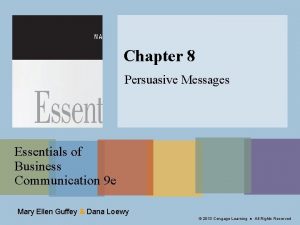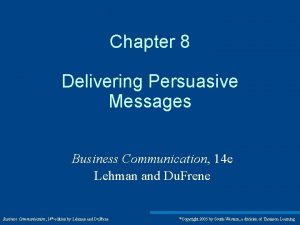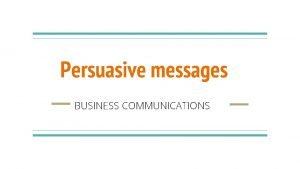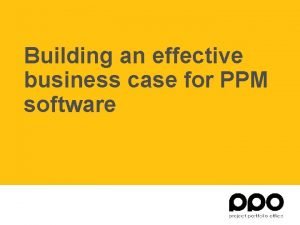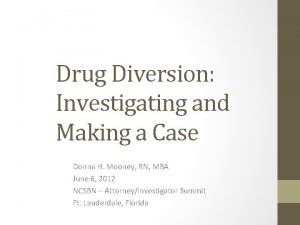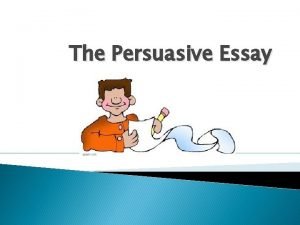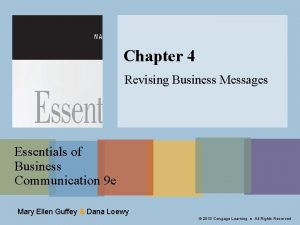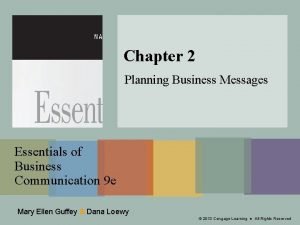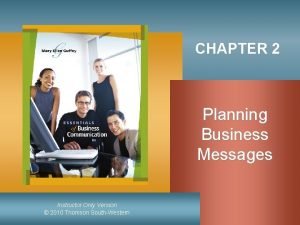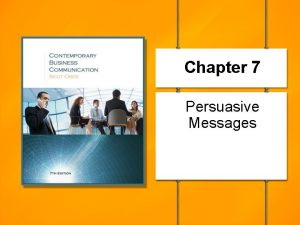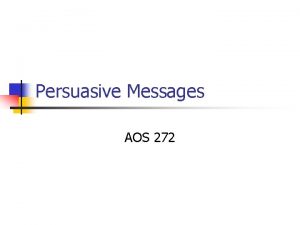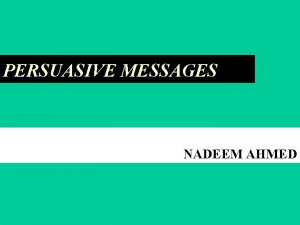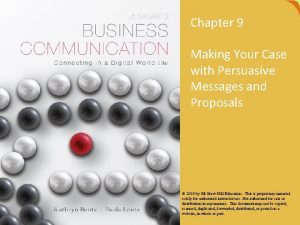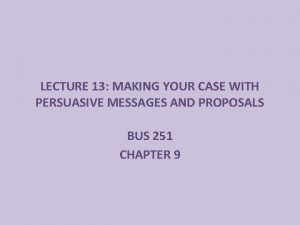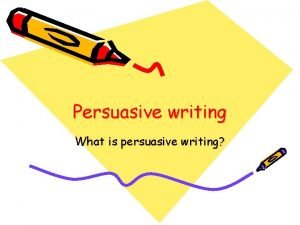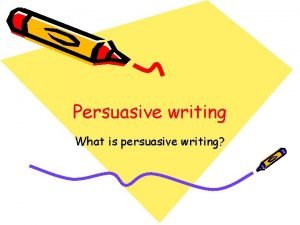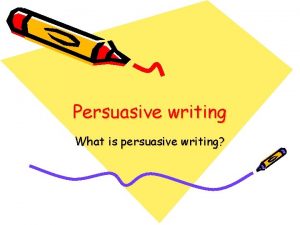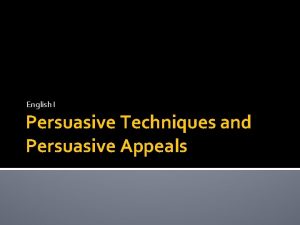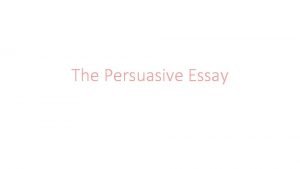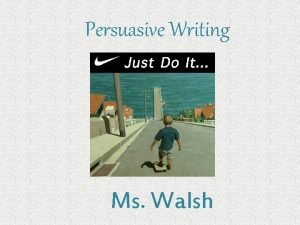Chapter 9 Making Your Case with Persuasive Messages















- Slides: 15

Chapter 9 Making Your Case with Persuasive Messages and Proposals © 2014 by Mc. Graw-Hill Education. This is proprietary material solely for authorized instructor use. Not authorized for sale or distribution in any manner. This document may not be copied, scanned, duplicated, forwarded, distributed, or posted on a © 2014 by Mc. Graw-Hill Education. This is proprietary material solely for authorized instructor use. Not authorized for sale or distribution in any manner. website, in whole or part. This document may not be copied, scanned, duplicated, forwarded, distributed, or posted on a website, in whole or part. 9 -1

Chapter Overview • • • Advice about persuasion Persuasive requests Ethical concerns Sales messages Proposals © 2014 by Mc. Graw-Hill Education. This is proprietary material solely for authorized instructor use. Not authorized for sale or distribution in any manner. This document may not be copied, scanned, duplicated, forwarded, distributed, or posted on a website, in whole or part. 9 -2

Advice About Persuasion (1 of 5) • • Know your readers. Choose and develop targeted reader benefits. Make good use of persuasive appeals. Make it easy for readers to comply. © 2014 by Mc. Graw-Hill Education. This is proprietary material solely for authorized instructor use. Not authorized for sale or distribution in any manner. This document may not be copied, scanned, duplicated, forwarded, distributed, or posted on a website, in whole or part. 9 -3

Know Your Readers (2 of 5) • Especially important with persuasion • Can use formally gathered information (marketing reports, surveys, focus groups) • Can gather information informally (study customer notes, talk with service personnel and other employees, look at other messages that have succeeded) © 2014 by Mc. Graw-Hill Education. This is proprietary material solely for authorized instructor use. Not authorized for sale or distribution in any manner. This document may not be copied, scanned, duplicated, forwarded, distributed, or posted on a website, in whole or part. 9 -4

Choose Winning Reader Benefits (3 of 5) • These can be – Tangible – Intangible • They can also be – Intrinsic – Extrinsic © 2014 by Mc. Graw-Hill Education. This is proprietary material solely for authorized instructor use. Not authorized for sale or distribution in any manner. This document may not be copied, scanned, duplicated, forwarded, distributed, or posted on a website, in whole or part. 9 -5

Use Winning Appeals (4 of 5) • Logic based (logos) • Emotion based (pathos) • Character based (ethos) © 2014 by Mc. Graw-Hill Education. This is proprietary material solely for authorized instructor use. Not authorized for sale or distribution in any manner. This document may not be copied, scanned, duplicated, forwarded, distributed, or posted on a website, in whole or part. 9 -6

Make It Easy for Readers to Comply (5 of 5) • Don’t neglect the action part of the message. • Make the desired action clear. • Make the desired action as easy as possible to perform. © 2014 by Mc. Graw-Hill Education. This is proprietary material solely for authorized instructor use. Not authorized for sale or distribution in any manner. This document may not be copied, scanned, duplicated, forwarded, distributed, or posted on a website, in whole or part. 9 -7

Plan for Persuasive Requests • Open with words that – set up the strategy and – gain attention. • Present the strategy (the persuasion), using persuasive language and you-viewpoint. • As a logical follow-up, make the request clearly and without negatives. • End the message with the request or with words that recall the appeal. © 2014 by Mc. Graw-Hill Education. This is proprietary material solely for authorized instructor use. Not authorized for sale or distribution in any manner. This document may not be copied, scanned, duplicated, forwarded, distributed, or posted on a website, in whole or part. 9 -8

Good Persuasive Strategy (1 of 4) Opening Dear Ms. Mc. Laughlin: I’m sure you’d agree that business communication teachers need to be in touch with business experts in the field. Experienced professionals like you can give teachers the realistic input that is so important to their practical coursework. © 2014 by Mc. Graw-Hill Education. This is proprietary material solely for authorized instructor use. Not authorized for sale or distribution in any manner. This document may not be copied, scanned, duplicated, forwarded, distributed, or posted on a website, in whole or part. 9 -9

Good Persuasive Strategy (2 of 4) Body For this reason, I believe that you could make an important contribution to the national meeting of the Association for Business Communication, which will be held in New Orleans at the Sheraton Hotel, October 28 -31. This conference brings together about 300 business communication professors from around the US and the world who are looking for ways to keep their teaching abreast of current practice. Your perspective could be especially valuable to them. © 2014 by Mc. Graw-Hill Education. This is proprietary material solely for authorized instructor use. Not authorized for sale or distribution in any manner. This document may not be copied, scanned, duplicated, forwarded, distributed, or posted on a website, in whole or part. 9 -10

Good Persuasive Strategy (3 of 4) Body Continued Could you join us on Friday afternoon from 2: 00 to 2: 45 pm to tell us about your work as a supervisor at Lexmark? What common writing problems do you see, and what do you think we should be doing in the colleges to help our students avoid them? How can we better prepare our students for writing in the workplace? Any insights you could share on these and related topics would be much appreciated. You would not need to prepare a formal presentation. In fact, anecdotes and examples from your work would be preferred. You could speak for about 30 minutes, leaving 15 minutes for discussion. Since your talk would be one of several break-out sessions, it would be attended by 30 -40 people, making for a relaxed, conversational atmosphere. © 2014 by Mc. Graw-Hill Education. This is proprietary material solely for authorized instructor use. Not authorized for sale or distribution in any manner. This document may not be copied, scanned, duplicated, forwarded, distributed, or posted on a website, in whole or part. 9 -11

Good Persuasive Strategy (4 of 4) Closing Will you please share your experiences and advice with us? By doing so, you will help us help hundreds of business-writing students. Since I will be compiling the final program on the 15 th, please let me know by the 10 th if you can join us. Sincerely, © 2014 by Mc. Graw-Hill Education. This is proprietary material solely for authorized instructor use. Not authorized for sale or distribution in any manner. This document may not be copied, scanned, duplicated, forwarded, distributed, or posted on a website, in whole or part. 9 -12

Preliminary Steps for Sales Writing • Learn the product or service you sell. – How it is made – How it works – What it will do • Learn about the prospective customers. – Their economic status – Their nationalities – Their ages – Etc. © 2014 by Mc. Graw-Hill Education. This is proprietary material solely for authorized instructor use. Not authorized for sale or distribution in any manner. This document may not be copied, scanned, duplicated, forwarded, distributed, or posted on a website, in whole or part. 9 -13

Determining the Central Appeal Three kinds: • Logical – appeals to the thinking mind (saving money, making money, doing a better job, getting better use) • Emotional – appeals to the senses (feeling, tasting, smelling, hearing) • Character based – uses the writer or spokesperson’s voice and projected image to win trust and invite readers to identify with the speaker © 2014 by Mc. Graw-Hill Education. This is proprietary material solely for authorized instructor use. Not authorized for sale or distribution in any manner. This document may not be copied, scanned, duplicated, forwarded, distributed, or posted on a website, in whole or part. 9 -14

Conventional Plan of the Sales Message • Begin with words that set up the sales presentation and gain attention. • Present the sales message using imagination, persuasive language, and you-viewpoint. • Include sufficient information to convince. • Then drive for the sale, making it clear, and using appropriate strength. • Urge immediate action. • May recall basic appeal in final words. 9 -15
 Best worst and average case
Best worst and average case What is persuasive messages in business communication
What is persuasive messages in business communication 14. what are persuasive messages?
14. what are persuasive messages? What is persuasive messages in business communication
What is persuasive messages in business communication What is inferring
What is inferring War making and state making as organized crime
War making and state making as organized crime Give us your hungry your tired your poor
Give us your hungry your tired your poor Ppm implementation costs
Ppm implementation costs Investigating and making a case for drug diversion
Investigating and making a case for drug diversion Keeping your hands clean and dry persuasive essay
Keeping your hands clean and dry persuasive essay Chapter 4 revising business messages answers
Chapter 4 revising business messages answers Chapter 2 planning business messages
Chapter 2 planning business messages Planning business messages chapter 2
Planning business messages chapter 2 Short case vs long case
Short case vs long case Worst case and average case of binary search tree
Worst case and average case of binary search tree Case western reserve university case school of engineering
Case western reserve university case school of engineering

